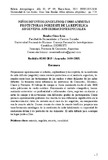| dc.rights.license | http://creativecommons.org/licenses/by-nc-sa/3.0/ve/ | |
| dc.contributor.author | Bondar, César Iván | |
| dc.date.accessioned | 2015-07-27T20:14:08Z | |
| dc.date.available | 2015-07-27T20:14:08Z | |
| dc.date.issued | 2015-01 | |
| dc.identifier.issn | 1325-2610 | |
| dc.identifier.uri | http://www.saber.ula.ve/handle/123456789/40728 | |
| dc.description.abstract | Proponemos aproximarnos al estudio, exploratorio y descriptivo, de la condición de niño difunto (angelito) como animita protectora en el nordeste argentino, tomando como base los testimonios de las madres y otros dolientes de los niños difuntos. Se tomarán como referencia las provincias de Corrientes, Misiones, Chaco y Formosa. El trabajo de campo se viene realizando desde el año 2006 entre población de credo católico. Priorizando el método etnográfico, hemos realizado entrevistas en profundidad a informantes clave, registros en diarios y notas de campo y observaciones con diferentes grados de participación. Como primera aproximación podemos dar cuenta de una diferencia significativa en la construcción del status de animita en el caso de los angelitos, en comparación con la muerte adulta. Damos cuenta de cómo la muerte biofísica propicia una transformación ontológica de la condición de niño habilitando su capacidad de mediación divina y de protector de sus dolientes. El niño difunto pasa a ocupar un lugar junto a Dios. | es_VE |
| dc.language.iso | es | es_VE |
| dc.rights | info:eu-repo/semantics/openAccess | |
| dc.subject | animita | es_VE |
| dc.subject | angelito | es_VE |
| dc.subject | muerte | es_VE |
| dc.subject | sacralidad | es_VE |
| dc.title | Niños difuntos (Angelitos) como Animitas Protectoras. Nordeste de la República Argentina. Aproximaciones iniciales | es_VE |
| dc.title.alternative | Deceased children (little angels) as protective spirits (animas) – northeastern Argentina – a tentative approach | es_VE |
| dc.type | info:eu-repo/semantics/article | |
| dc.description.abstract1 | That which is presented here is merely an explorative and descriptive approach to the subject of the deceased child, known as the little angel or protective spirit. Accounts regarding this subject were recorded in interviews with the mothers of the deceased and other bereaved persons in the Provinces of Corrientes, Misiones, Chaco and Formosa. Since the year 2006 field work was performed amongst people of the Catholic faith. Giving priority to ethnographic method, information was received from certain key persons, as well as from newspapers, and observations made in the field at varying levels of participation. In keeping with our tentative approach we can say that constructs hazarded in regard to the status of the anima of these little angels there is a significant difference between its quality and that involving the decease of an adult. We can also say that biophysical death inaugurates an ontological transformation in the child which enables the capacity for divine mediation and for the protection of those bereaved. The deceased child comes to be in a position near to God. | es_VE |
| dc.description.colacion | 7-24 | es_VE |
| dc.description.email | cesarivanbondar@gmail.com | es_VE |
| dc.description.frecuencia | Semestral | |
| dc.identifier.depositolegal | ppi201403ME788 | |
| dc.publisher.pais | Venezuela | es_VE |
| dc.subject.dependencia | Museo Arqueológico "Gonzalo Rincón Gutiérrez" | es_VE |
| dc.subject.institucion | Universidad de Los Andes | es_VE |
| dc.subject.keywords | little animas | es_VE |
| dc.subject.keywords | little angels | es_VE |
| dc.subject.keywords | death | es_VE |
| dc.subject.keywords | sacredness | es_VE |
| dc.subject.publicacionelectronica | Boletín Antropológico | |
| dc.subject.seccion | Boletín Antropológico: Artículos | es_VE |
| dc.subject.thematiccategory | Artes y Humanidades | es_VE |
| dc.subject.tipo | Revistas | es_VE |
| dc.type.media | Texto | es_VE |



